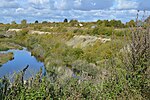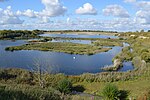St Mary's Church, Pitstone
Church of England church buildings in BuckinghamshireChurches preserved by the Churches Conservation TrustEnglish Gothic architecture in BuckinghamshireGrade I listed churches in BuckinghamshirePitstone ... and 1 more
Use British English from February 2023

St Mary's Church is a redundant Anglican church in the village of Pitstone, Buckinghamshire, England. It is recorded in the National Heritage List for England as a designated Grade I listed building, and is under the care of the Churches Conservation Trust. The church stands to the southeast of the village, some 9 miles (14 km) east of Aylesbury.
Excerpt from the Wikipedia article St Mary's Church, Pitstone (License: CC BY-SA 3.0, Authors, Images).St Mary's Church, Pitstone
Church Road,
Geographical coordinates (GPS) Address Nearby Places Show on map
Geographical coordinates (GPS)
| Latitude | Longitude |
|---|---|
| N 51.8251 ° | E -0.6341 ° |
Address
Church Road
LU7 9HA , Pitstone
England, United Kingdom
Open on Google Maps









